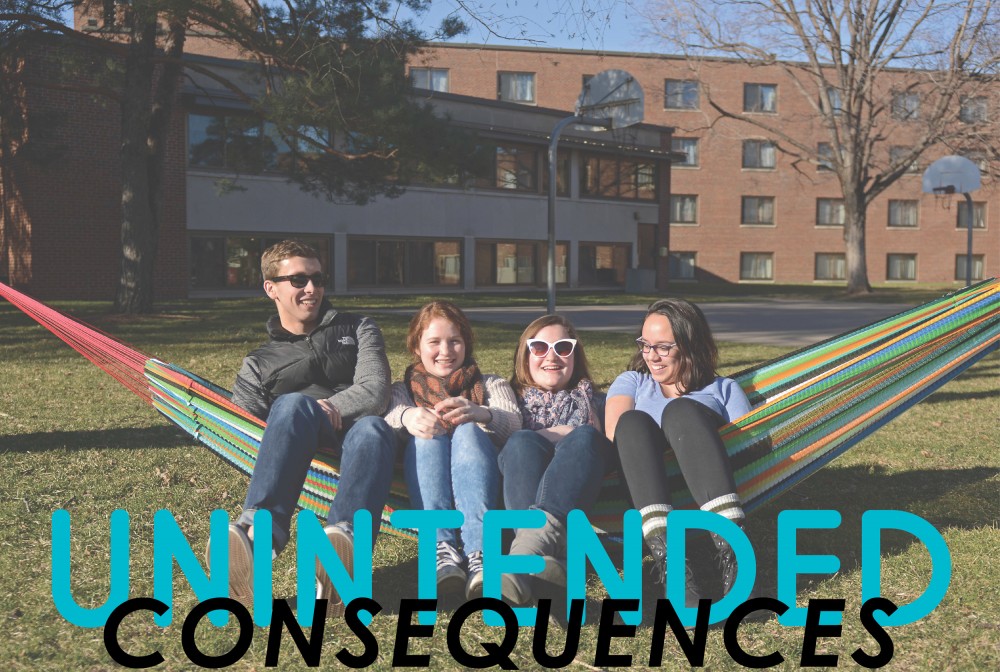Though they bonded in freshman dorms, the four friends couldn’t wait to move into a place of their own off campus.
First-year students Grant Zastoupil, Laurel Darling, Alex Mickelson and Alison Gould — who belong to one of the University’s largest freshman classes — met in September after moving into the Centennial and Frontier residence halls.
 The group illustrates what University of Minnesota administrators have long called the goal of campus housing: creating a community that boosts connections in and out of class. Now, some administrators want to pull students from private development back into University housing after freshman year.
The group illustrates what University of Minnesota administrators have long called the goal of campus housing: creating a community that boosts connections in and out of class. Now, some administrators want to pull students from private development back into University housing after freshman year.
Last May, administrators presented the Board of Regents with a new housing strategy, which laid out on-campus housing issues and possible solutions. Since then, the regents have debated goals for housing and enrollment at nearly every following meeting.
Some members of the board favor removal or renovation of some or all of the Superblock, but other administrators are tentative to remove all four dorms, citing high costs.
In February, administrators presented a tentative 30-year plan that includes demolishing Centennial Hall and Territorial Hall and building new dorms along East River Road.
An increase in the proportion of students living on or near campus coincided with a rise in students applying for University housing. Paired with an increase in off-campus luxury apartments, the changes have prompted leaders to address housing issues on campus.
Years of inaction created an overflow of students applying for University housing. Luxury apartments have swelled near campus to fill the demand.
School officials at the University and across the country have looked to the Ohio State University’s housing revamp as an example. That program entailed building apartment-style dorms and requiring second-year students to live on campus.
Still, housing isn’t at the top of the University’s priority list, often taking a backseat to projects like the M Health rebranding and administrative restructuring.
As school officials work to define their plans, they remain divided on the best approach to bolster the University’s living spaces.
Lagging behind peers
All of the other 13 schools in the Big Ten have finalized plans for new housing or started construction. Most projects will finish their first phase by 2018 at the latest, though some schools’ plans extend far into the future.
By June, regents at the University of Minnesota want to at least solidify parts of a housing plan for the school, said Regent Thomas Devine, who has taken a lead on housing on the board.
 Throughout the past year, regents have raised the Ohio State University — where a $370 million project will add 3,200 beds — as an example of a Big Ten university that has already moved to update its housing.
Throughout the past year, regents have raised the Ohio State University — where a $370 million project will add 3,200 beds — as an example of a Big Ten university that has already moved to update its housing.
“[Their project] is the most innovative thing I’ve seen in the country in the past five or six years,” said Devine, who estimates he has visited about 200 schools.
Similar to the University, many OSU students live off campus in dense apartment buildings and single-family rental homes.
Starting this fall, the school will require sophomores to live on campus and take a required course similar to the one for first-year students, said Dave Isaacs, spokesman for OSU’s Office of Student Life. He said officials hope the new program will bump GPAs and graduation rates.
“In the first year, students are acclimating. In the second, they’re transitioning to post-grad,” Isaacs said.
OSU’s plans came after “massive research” into how students’ needs have changed, he said.
“This isn’t just where you go to sleep,” Isaacs said.
At the University of Minnesota, first-year students who live on campus have GPAs .2 to .3 points higher and four-year graduation rates 10 to 14 percent higher than those who do not, according to a University housing report.
Molly Arntson, an international relations and diplomacy sophomore at OSU, said the proximity to campus helped her access academic resources.
Though students may initially be skeptical of living in university housing for two years and taking a required class, Arntson said, she thinks they would acclimate fairly quickly.
Some University of Minnesota students disagree. Computer science first-year Alison Gould said she’d be against extending the first-year required classes to sophomores because, to her, they were made up of busywork.
 And genetics, cell biology and development first-year Grant Zastoupil said while living in the dorms has pushed him to attend more classes, he thinks it’s natural for sophomores to shift off campus and take on more responsibilities, such as paying bills.
And genetics, cell biology and development first-year Grant Zastoupil said while living in the dorms has pushed him to attend more classes, he thinks it’s natural for sophomores to shift off campus and take on more responsibilities, such as paying bills.
Some regents have urged each other and administrators to consider modern designs in new buildings to attract students in their second year, Devine said.
“For me, it’s not an economic decision,” Devine said. “Ohio State passed over an economic decision to make a structural one.”
The demand for housing is increasing enough to need a new dorm every three years, Devine said.
The University’s current strategy to remodel 82-year-old Pioneer Hall and 57-year-old Frontier Hall would cost about $170 million, he said.
The University built the 17th Avenue residence hall to stem growing demand. Some regents say the decision to use a traditional dorm layout there overlooked changing student expectations.
“I think it’s time we asked ourselves,” Devine said, “‘Are we delivering the product we should have?’”

Catching up to competition
In the early ’00s, the University decided to let private developers meet demand in lieu of building University housing. And in the past seven years, the University has turned away from being a commuter school by encouraging more students to live on and near campus.
Coupled together, Devine said those decisions were a mistake with “unintended consequences” that the school is now paying for.
The Board’s inaction allowed private developers to take over the housing market, driving up the overall cost of attendance with more expensive rents in dense luxury apartments, Devine said.
Ed Goetz, director of the University’s Center for Urban and Regional Affairs, said luxury apartments have drawn students away from older, single-family homes in surrounding neighborhoods and from campus housing.
But Regent Michael Hsu said students pay for the luxury. He said off-campus housing costs soar above those of the University’s residence halls, which rank second to last in the Big Ten, just above Wisconsin for room and board.
Regardless, the growth of both campus and private housing helps the area thrive, Goetz said.
But the rise of off-campus apartments hasn’t filled the demand that was created by the University’s move away from the commuter model, Goetz said.
“The commuter model failed,” Devine said. “We have committed to housing students but don’t have enough room.”
 While finding a balance between providing campus housing and accepting private off-campus options has proven difficult for the University, there have been successes.
While finding a balance between providing campus housing and accepting private off-campus options has proven difficult for the University, there have been successes.
James Cargill built the Dinnaken Properties on the East Bank as a private developer and donated his buildings posthumously to the University in 2006. They are now managed by the University of Minnesota Foundation.
The donation, worth $38 million, is an example of the long-term relationships University administrators should be building, Devine said.
Nevertheless, a tension exists between the University and private developers, Goetz said, which affects the school’s revenue.
“The development of so much private housing right in the vicinity … will certainly pressure the University into thinking long and hard about the housing stock within the dorms and within the University land,” Goetz said. “There’s much more competition for student housing out there than there has [been] in the past.”






















